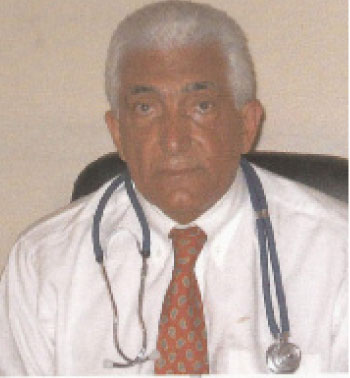
When your heart pumps blood to bring oxygen to the body’s cells, the blood pushes against the walls of the arteries. When that pushing, or blood pressure, against the arteries is strong and continuous, it can weaken the walls of the arteries and cause stroke, heart attack and kidney failure.
High blood pressure is one of several ‘risk factors’ that can increase your chance of developing heart disease, a stroke, and other serious conditions. As a rule, the higher the blood pressure, th greater the risk. Treatment includes a change in lifestyle risk factors where these can be improved - losing weight if you are overweight, regular physical activity, a healthy diet, cutting back if you drink a lot of alcohol, stopping smoking, and a low salt and caffeine intake. If needed, medication can lower blood pressure.
Normal blood pressure is the pressure of blood in the arteries (blood vessels). Blood pressure is measured in millimetres of mercury (mmHg). Your blood pressure is recorded as two figures.
For example, high blood pressure of 150/95 mmHg. This is said as ‘150 over 95’.
The top (first) number is the systolic pressure. This is the pressure in the arteries when the heart contracts.
The bottom (second) number is the diastolic pressure. This is the pressure in the arteries when the heart rests between each heartbeat.
What is high blood pressure?
High blood pressure is a blood pressure that is 140/90 mmHg or above each time it is taken. However, it is not quite as simple as this. Depending on various factors, the level at which blood pressure is considered high enough to be treated with medication can vary from person to person.
Blood pressure of 160/100 mmHg or above This is definitely high. All people with a blood pressure that stays at this level are usually offered medication to lower it.
Blood pressure of 140/90 mmHg or above but below 160/100 mmHg
This is sometimes called ‘mild’ high blood pressure. Ideally, it should be lower than this but for many people the risk from mild high blood pressure is small, and drug treatment is not indicated. However, certain groups of people with blood pressure in this range are advised medication to lower it. These are people with:
a high risk of developing cardiovascular diseases (heart and blood vessels disease), or an existing cardiovascular disease, or diabetes, or
Damage to the heart or kidney (organ damage) due to high blood pressure.
Smoking and high blood pressure
Smoking does not directly affect the level of your blood pressure. However, smoking greatly adds to your health risk if you already have high blood pressure. If you smoke, you should make every effort to stop. If you smoke and are having difficulty in stopping, then see the Doctor or nurse for help and advice.
How is high blood pressure diagnosed?
A one-off blood pressure reading that is high does not mean that you have ‘high blood pressure’. Your blood pressure varies throughout the day. It may be high for a short time if you are anxious, stressed, or have just been exercising.
You are said to have ‘high blood pressure’ (hypertension) if you have several blood pressure readings that are high, and which are taken on different occasions, and when you are relaxed.
Observation period
If one reading is found to be high, it is usual for your doctor or nurse to advise a time of observation. This means several blood pressure checks at intervals over time. The length of the observation period varies depending on the initial reading, and if you have other health risk factor
For example, say a first reading was mildly high at 150/94 mmHg. If you are otherwise well, then a period of several months ‘observation’ may be advised. A blood pressure reading may be taken every few weeks. The observation period is also a good time to change any lifestyle factors that can reduce blood pressure. If the blood pressure readings remain high after an observation period then treatment with medication may be advised, depending on your risk factors .
However, if you have diabetes, or have recently had a heart attack or stroke, you may be advised to have blood pressure checks fairly often over the next week or so. Also, treatment with medication is usually considered at an earlier stage if the readings remain high.
What causes high blood pressure?
The cause is not known in most cases
This is called ‘essential hypertension’. The pressure in the arteries (blood vesses) depends on how hard the heart pumps, and how much resistance there is in the arteries. It is thought that slight narrowing of the arteries increases the resistance to blood flow, which increases the blood pressure. The cause of the slight narrowing of the arteries is not clear. Various factors probably contribute.
In some cases, high blood pressure is caused by other conditions
It is then called ‘secondary hypertension’. For example, certain kidney or hormone problems can cause high blood pressure.
How common is high blood pressure?
About half of people, middle age, and about 1 in 4 middle aged adults, have high blood pressure. It is less common in younger adults. Most cases are mildly high (up to 160/100 mmHg). However, at least 1 in 20 adults have blood pressure of 160/100 mmHg or above. High blood pressure is more common in people:
With diabetes. About 3 in 10 people with Type 1 diabetes and more than half of people with Type 2 diabetes eventually develop high blood pressure.
From African-Caribbean origin.
With a family history of high blood pressure.
With certain lifestyle factors. That is, those who: are overweight, eat a lot of salt, don’t eat many fruit and vegetables, and don’t take enough exercise, drink a lot of coffee (or other caffeine-rich drinks), in the Gambia drinking regularly the strong tea (Ataya) with excessive of sugar, or drink a lot of alcohol.
Who should have a blood pressure check?
Mild high blood pressure usually causes no symptoms. You will not know if you have high blood pressure unless you have your blood pressure checked. Therefore, everyone should have regular blood pressure checks at least
The check should be more often (at least once a year) in: older people, people who have had a previous high reading, people with diabetes, and people who have had a previous reading between 130/85 and 139/89 mmHg.
Why is high blood pressure a problem if it causes no symptoms?
High blood pressure is a ‘risk factor’ for developing a cardiovascular disease (such as a heart attack or stroke), and kidney damage, sometime in the future. If you have high blood pressure, over the years it may do some damage to your arteries and put a strain on your heart. In general, the higher your blood pressure, the greater the health risks. But, high blood pressure is just one of several possible risk factors for developing a heart disease.
Risk factors for heart diseases
Certain ‘risk factors’ increase the risk. These include:
Lifestyle risk factors that can be prevented or changed:
Smoking
Lack of physical activity (a sedentary lifestyle).
Obesity (over weight)
An unhealthy diet.
Excess alcohol.
Treatable or partly treatable risk factors:
Hypertension (high blood pressure).
High cholesterol blood level.
High (fat) blood level.
Diabetes.
Kidney diseases that affect kidney function.
Fixed risk factors - ones that you cannot alter:
A strong family history. This means if you have a father or brother who developed heart disease or a stroke before they were 55, or in a mother or sister before they were 65.
Being male
An early menopause in women.
Age. The older you become, the more likely you are to develop high blood pressure.
However, if you have a fixed risk factor, you may want to make extra effort to tackle any lifestyle risk factors that can be changed.
Note: some risk factors are more ‘risky’ than others. For example, smoking and high blood pressure probably cause a greater risk to health than over weight. Also, risk factors interact. So, if you have two or more risk factors, your health risk is much more increased than if you just have one. For example, a middle aged male smoker who takes no exercise and has high blood pressure has a high risk of developing such as a heart attack before the age of 60.
Therefore, the benefit of lowering a high blood pressure is to reduce the risk of developing the above disease in the future.
When do you need further tests?
If you are diagnosed as having high blood pressure then you are likely to be examined by your doctor and have some routine tests which include:
A urine test to check if you have protein or blood in your urine.
A blood test to check that your kidneys are working fine, and to check your cholesterol level and sugar (glucose) level.
A heart tracing (an electrocardiogram, also called an ECG).
For other ‘risk factors’ such as a high cholesterol level or diabetes
Lose weight if you are overweight
Losing excess weight has other health benefits too.Losing some excess weight can make a big difference. Blood pressure can fall by up to 2.5/1.5 mm Hg for each excess
Regular physical activity
If possible, aim to do some physical activity on five or more days of the week, for at least 30 minutes. For example, brisk walking, swimming, cycling, dancing, etc. Regular physical activity can lower blood pressure in addition to giving other health benefits. If you previously did little physical activity, and change to doing regular physical activity five times a week, it can reduce systolic blood pressure by 2-10 mmHg.
Eat a healthy diet
Briefly, this means:
AT LEAST five portions, and ideally 7-9 portions, of a variety of fruit and vegetables per day.
THE BULK OF MOST MEALS should be starch-based foods (such as cereals, wholegrain bread, potatoes, rice, pasta), plus fruit and vegetables.
NOT MUCH fatty food such as fatty meats, cheeses, full-cream milk, fried food, butter, etc. Use low fat, mono-, or poly-unsaturated spreads.
INCLUDE 2-3 portions of fish per week. At least one of which should be ‘oily’ such as herring, mackerel, sardines, kippers, pilchards, salmon, or fresh (not tinned) tuna.
If you eat meat it is best to eat lean meat, or poultry such as chicken.
If you do fry, choose a vegetable oil such as sunflower, rapeseed or olive oil.
Low in salt.
A healthy diet provides benefits in different ways. For example, it can lower cholesterol, help control your weight, and has plenty of vitamins, fibre, and other nutrients which help to prevent certain diseases. Some aspects of a healthy diet also directly affect blood pressure. For example, if you have a poor diet and change to a diet which is low-fat, low-salt, and high in fruit and vegetables, it can lower systolic blood pressure by up to 11 mmHg.
Have a low salt intake
The amount of salt that we eat can have an effect on our blood pressure. We should have no more than 5-6 grams of salt per day. (Most people currently have more than this.) Tips on how to reduce salt include:
Use herbs and spices to flavour food rather than salt.
Limit the amount of salt used in cooking, and do not add salt to food at the table.
Choose foods labelled ‘no added salt’, and avoid processed foods as much as possible.
Restrict your number of tea and coffee drinks
Caffeine is thought to have a modest effect on blood pressure. It is advised that you restrict your coffee consumption (and other caffeine-rich drinks, as example Ataya tea.
Cutting back on heavy drinking improves health in various ways. It can also have a direct effect on blood pressure. For example, if you are drinking heavily, cutting back to the recommended limits can lower a high systolic blood pressure by up to 10 mmHg.
Lifestyle - in summary
It is estimated that dietary and exercise interventions discussed above can reduce blood pressure by at least 10 mmHg in about 1 in 4 people with high blood pressure.
Treatment with medication
When is drug treatment started for high blood pressure?
Drug treatment to lower blood pressure is usually advised for:
All people who have a blood pressure that remains at 160/100 mmHg or above after a trial of any relevant lifestyle changes.
People with a blood pressure that remains at 140/90 mmHg or above after a trial of any relevant lifestyle changes AND who have:diabetes, or an existing cardiovascular disease, If you are taking medication to lower high blood pressure:This generally applies to people who have diseases where very good blood pressure control is important. This includes:
People who have a heart disease.
People with diabetes.
People who have a long term kidney disease.
For further information visit any Government Hospitals, clinics, any NGO and Private clinics or E Mail azadehhassan@yahoo.co.uk and text DR Azadeh 002207774469/3774469 during working days from 3-6 pm.
Author Dr Azadeh, Senior Lecturer at the University of the Gambia and Senior Physician




